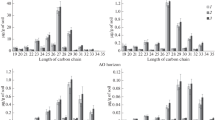Abstract
Fungi play an important role as microbial decomposers of plant litter in streams, forests, grasslands and various other terrestrial and freshwater environments. The most basic parameter to assess their quantitative importance in these ecosystems is fungal biomass. Consequently, various approaches have been used over the past decades to estimate fungal biomass in decomposing plant litter, among which the quantification of ergosterol as a biomarker largely restricted to fungi has been the most popular. This chapter describes a procedure to quantify ergosterol in decomposing leaf litter. The presented method involves hot methanol extraction of lipids from leaves colonized by fungi, followed by solid-phase extraction (SPE), and the purification and quantification of ergosterol by high-performance liquid chromatography (HPLC) with UV detection at 282 nm. Application of the method has been successful in a variety of environments and has shown that fungal growth in leaf litter can lead to a biomass accrual exceeding 15% of total litter dry mass. This finding has been instrumental in demonstrating a key role of fungi in the litter decomposition process.
Access this chapter
Tax calculation will be finalised at checkout
Purchases are for personal use only
Similar content being viewed by others
References
Baudy, P., Zubrod, J. P., Röder, N., Baschien, C., Feckler, A., Schulz, R., & Bundschuh, M. (2019). A glance into the black box: Novel species-specific quantitative real-time PCR assays to disentangle aquatic hyphomycete community composition. Fungal Ecology, 42, 100858.
Beni, A., Soki, E., Lajtha, K., & Fekete, I. (2014). An optimized HPLC method for soil fungal biomass determination and its application to a detritus manipulation study. Journal of Microbiological Methods, 103, 124–130.
Brosed, M., Jabiol, J., & Gessner, M. O. (2017). Nutrient stoichiometry of aquatic hyphomycetes: Interstrain variation and ergosterol conversion factors. Fungal Ecology, 29, 96–102.
Buesing, N., & Gessner, M. O. (2006). Benthic bacterial and fungal productivity and carbon turnover in a freshwater marsh. Applied and Environmental Microbiology, 72, 596–605.
Charcosset, J.-Y., & Chauvet, E. (2001). Effect of culture conditions on ergosterol concentration in mycelium of aquatic hyphomycetes. Applied and Environmental Microbiology, 67, 2051–2055.
Gessner, M. O., & Chauvet, E. (1993). Ergosterol-to-biomass conversion factors for aquatic hyphomycetes. Applied and Environmental Microbiology, 85, 377–384.
Gessner, M. O., & Chauvet, E. (1994). Importance of stream microfungi in controlling breakdown rates of leaf litter. Ecology, 75, 1807–1817.
Gessner, M. O., & Newell, S. Y. (2002). Biomass, growth rate and production of filamentous fungi in plant litter. In C. J. Hurst, G. Knudsen, M. McInerney, L. D. Stetzenbach, & M. Walter (Eds.), Manual of environmental microbiology (2nd ed., pp. 295–308). Washington: American Society for Microbiology.
Gessner, M. O., & Schmitt, A. L. (1996). Use of solid-phase extraction to determine ergosterol concentrations in plant tissue colonized by fungi. Applied and Environmental Microbiology, 62, 415–419.
Graça, M. A. S. (2001). The role of invertebrates on leaf litter decomposition in streams – A review. International Review of Hydrobiology, 86, 383–393.
Gulis, V., Kuehn, K. A., Schoettle, L. N., Leach, D., Benstead, J. P., & Rosemond, A. D. (2017). Changes in nutrient stoichiometry, elemental homeostasis and growth rate of aquatic litter-associated fungi in response to inorganic nutrient supply. The ISME Journal, 11, 2729–2739.
Hieber, M., & Gessner, M. O. (2002). Contribution of stream detritivores, fungi and bacteria to leaf breakdown based on biomass estimates. Ecology, 83, 1026–1038.
Klamer, M., & Bảảth, E. (2004). Estimation of conversion factors for fungal biomass determination in compost using ergosterol and PLFA 18:2ω6,9. Soil Biology and Biochemistry, 36, 57–65.
Maharning, A. R., & Bärlocher, F. (1996). Growth and reproduction in aquatic hyphomycetes. Mycologia, 88, 80–88.
Newell, S. Y. (1992). Estimating fungal biomass and productivity in decomposing litter. In G. C. Carroll & D. T. Wicklow (Eds.), The fungal community. Its organization and role in the ecosystem (2nd ed., pp. 521–561). New York: Marcel Dekker.
Reis, F., Nascimento, E., Castro, H., Canhoto, C., Gonçalves, A. L., Simões, S., García-Palacios, P., Milla, R., Sousa, J. P., & Martins da Silva, P. (2018). Land management impacts on the feeding preferences of the woodlouse Porcellio dilatatus (Isopoda: Oniscidea) via changes in plant litter quality. Applied Soil Ecology, 132, 45–52.
Suberkropp, K. (1992). Interactions with invertebrates. In F. Bärlocher (Ed.), The ecology of aquatic hyphomycetes, (Ecological studies, Vol. 94, pp. 118–133). Berlin: Springer.
Suberkropp, K., Gulis, V., Rosemond, A. D., & Benstead, J. P. (2010). Ecosystem and physiological scales of microbial responses to nutrients in a detritus-based stream: Results of a 5-year continuous enrichment. Limnology and Oceanography, 55, 149–160.
Wallander, H., Ekblad, A., Godbold, D. L., Johnson, D., Bahr, A., Baldrian, P., Björk, R. G., Kieliszewska-Rokicka, B., Kjøller, R., Kraigher, H., Plassard, C., & Rudawska, M. (2013). Evaluation of methods to estimate production, biomass and turnover of ectomycorrhizal mycelium in forests soils – A review. Soil Biology and Biochemistry, 57, 1034–1047.
Young, J. C. (1995). Microwave-assisted extraction of the fungal metabolite ergosterol and total fatty-acids. Journal of Agricultural and Food Chemistry, 43, 2904–2910.
Zhang, H., Wolf-Hall, C., & Hall, C. (2008). Modified microwave-assisted extraction of ergosterol for measuring fungal biomass in grain cultures. Journal of Agricultural and Food Chemistry, 56, 11077–11080.
Author information
Authors and Affiliations
Corresponding author
Editor information
Editors and Affiliations
Rights and permissions
Copyright information
© 2020 Springer Nature Switzerland AG
About this chapter
Cite this chapter
Gessner, M.O. (2020). Ergosterol as a Measure of Fungal Biomass. In: Bärlocher, F., Gessner, M., Graça, M. (eds) Methods to Study Litter Decomposition. Springer, Cham. https://doi.org/10.1007/978-3-030-30515-4_27
Download citation
DOI: https://doi.org/10.1007/978-3-030-30515-4_27
Published:
Publisher Name: Springer, Cham
Print ISBN: 978-3-030-30514-7
Online ISBN: 978-3-030-30515-4
eBook Packages: Biomedical and Life SciencesBiomedical and Life Sciences (R0)




